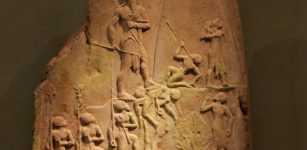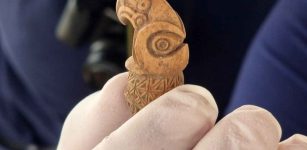What Was Humor Like In The 13th Century?
AncientPages.com - People love to laugh. They always have and humor has been a part of our history as long as humanity has existed. Historical records show that our ancestors appreciated to laugh just as much as we do today.
What many consider to be the world’s oldest joke is written in a medieval manuscript kept in the British Library. The language of the joke indicates that it was written about a thousand years ago. The text is written in Old Irish. You can read the world’s oldest joke here and see if it makes you laugh.
Historical studies of Icelandic Sagas reveal Vikings had dark humor and joked even during deadly battles.
It was a mixture of sarcasm, irony and unusual jokes. The Vikings approach was that, if you knew you were going to die, why not do it laughing.
We can also wonder - what was humor like in the 13th century?
We tend to think of the Middle Ages as grotesque and dreary.
However, 13th century elites made use of laughter quite deliberately – and it resounded most loudly when it was at someone else’s expense.
The things that medieval elites considered amusing can act as a window on their interpersonal relations: humour created a form of group solidarity and a clear distinction between friends and foes, thus revealing the power and value of entertainment, according to Beate Albrigtsen Pedersen at the Department of Archaeology, Conservation and History at the University of Oslo.
Pedersen seeks to explore what entertainment and comedy meant to Norwegian and Icelandic society and politics in the 13th century.
Humor has always been a part of our lives, and we have always had the ability to laugh at things, but there has been little research into the role of humor in medieval Norse society and how the forms of humor changed over time.

Is the world's oldest joke written on this 1,000-year-old ancient medieval manuscript? Image credit: British Library
The historian believes that knowledge about the jesting and spite favoured by the aristocracy can help us better understand the society and people of the 13th century.
"Humour is often regarded as a flippant research topic, but the ability to be amused and laugh is an important part of life and may thus provide us with an alternative perspective on the Middle Ages.
Our relationship to the saga literature is steeped in national romanticism, and I believe that reading it as entertainment literature will bring out new aspects.
The sagas were also intended to amuse people," she says.
No self-irony
The aristocrats knew well how to have a good time, according to Pedersen.
The elite used humour very deliberately – most often to ridicule others. Humour established a form of group affiliation and a clearer distinction between friends and foes.
See also:
Vikings Had Dark Humor And Joked Even During Deadly Battles
10 Most Bizarre Forms Of Ancient Taxes: Surprising And Funny
Is This The World’s Oldest Joke?
Bes – Ancient Egyptian Dwarf God Of Childbirth, Humor, Song and Dance
Sarcastic comments and put-downs are elements of our contemporary humour as well, but the essential matter is how it was perceived. Self-irony is a key element in Pedersen’s analysis of medieval humour, or more precisely: the absence of self-irony. With no redeeming self-irony, this form of humour was often used to defeat political opponents, or to assert oneself and shame others.
Modern humour is largely based on self-irony, permitting us to laugh at ourselves and others, without any repercussions.
Clearer norms of laughter
New courtly ideals were introduced in the late 13th century as the old society of rival chieftains was replaced by the ideal of the king as the sole ruler, chosen by God. Pedersen is studying what happened to humour during this transition and how the elite culture changed.
As the 13th century draws to an end, we can see clearer norms for what were permitted as objects of ridicule.
Vikings had dark humor and joked even during deadly battles.
The courtly ideals forced the elite to behave with more decorum, resulting in less ribaldry. At the same time, we can see that self-irony is becoming more common as the 14th century approaches.
Sarcastic comments by members of the elite no longer entailed the same grave consequences. They took the ridicule differently – by holding their heads high.
Written by and for a social elite
The humor researcher has reviewed a series of sagas, with sources ranging from the sagas of Icelanders and tales of kings and knights to ideological writings.
"I search for humorous features that recur in the sagas, such as ordinary jokes, insults, imagery and metaphors that evoke laughter in different scenes. If I come across similar situations, although laughter is not mentioned explicitly, I may assume that they were intended to be humorous as well," Pedersen says.
Pedersen uses the term humor, although this concept did not exist in medieval times.
"My research refers to our concept of humour. Humour remains a difficult concept to define. I study the things that they found comical, both what was intentionally comical and what was perceived as such, by the numerous characters in the sagas as well as by potential listeners in the 13th century," Pedersen explains.
Admittedly, all sources are concentrated at the upper echelons of society.
The sagas were written by and for an elite, so it’s difficult to draw any conclusions about the common people. Politics and everyday life went hand in hand for the aristocracy. It is essential to bear in mind that it is the sources’ portrayal of life – and how they wanted to describe the past and future – that emerges, Pedersen explains.
Kicking the little guy
In politics, humour was used to add fuel to rivalry and create conflicts – by laughing or remaining silent, the aristocrats took sides in the conflict.
"A prime example is in the story of the wedding at Reikholt in the early 12th century in Þorgils saga ok Hafliða, when a great feast was held," Pedersen says.
Black humor
Black humor also had a natural place in medieval life.
"The typical form this takes is a final punchline before someone dies. A concrete example is provided by Njáls Saga, in which there is a description of a swordfight that ends when one of the fighters cuts off the other man’s leg. Kol, the man with the severed leg, looks in alarm at the stump, and his adversary remarks: ‘There’s no need to look, it’s just like it seems, the leg is off.’ We may regard such final quotes as a dry form of humor, and I believe they were meant to be so at the time of writing as well," Pedersen explains.
Copyright © AncientPages.com All rights reserved. This material may not be published, broadcast, rewritten or redistributed in whole or part without the express written permission of AncientPages.com
More From Ancient Pages
-
 Gigantic Neolithic Newgrange Monument: A Temple, Astronomical Observatory Or Ancient Tomb?
Civilizations | Aug 14, 2016
Gigantic Neolithic Newgrange Monument: A Temple, Astronomical Observatory Or Ancient Tomb?
Civilizations | Aug 14, 2016 -
 Bulla Felix: Legendary Italian Leader Of Outlaws Who Robbed The Rich And Gave To The Poor
Featured Stories | Mar 23, 2023
Bulla Felix: Legendary Italian Leader Of Outlaws Who Robbed The Rich And Gave To The Poor
Featured Stories | Mar 23, 2023 -
 Science Unravels Some Secrets Of Mysterious Shipwreck Gribshunden
Archaeology | Sep 17, 2022
Science Unravels Some Secrets Of Mysterious Shipwreck Gribshunden
Archaeology | Sep 17, 2022 -
 Stunning Gold Jewelry And Artifacts From The Time Of Nefertiti Found In Bronze Age Tombs In Cyprus
Archaeology | Dec 2, 2021
Stunning Gold Jewelry And Artifacts From The Time Of Nefertiti Found In Bronze Age Tombs In Cyprus
Archaeology | Dec 2, 2021 -
 Mysterious Anomaly In Earth’s Magnetic Field Documented On 3,000-Year-Old Mesopotamian Bricks
Archaeology | Dec 18, 2023
Mysterious Anomaly In Earth’s Magnetic Field Documented On 3,000-Year-Old Mesopotamian Bricks
Archaeology | Dec 18, 2023 -
 The Norimitsu Odachi – Giant Japanese Sword Remains An Enigma
Artifacts | Mar 22, 2019
The Norimitsu Odachi – Giant Japanese Sword Remains An Enigma
Artifacts | Mar 22, 2019 -
 Living Descendant Of Legendary Native American Leader Sitting Bull Confirmed Using DNA From Hair
Archaeology | Oct 27, 2021
Living Descendant Of Legendary Native American Leader Sitting Bull Confirmed Using DNA From Hair
Archaeology | Oct 27, 2021 -
 Mysterious 2000-Year-Old Carved Vishap Stone Monuments Of Armenia
Featured Stories | Dec 13, 2016
Mysterious 2000-Year-Old Carved Vishap Stone Monuments Of Armenia
Featured Stories | Dec 13, 2016 -
 Did Climate Change End The Akkadian Empire?
Civilizations | Jul 17, 2019
Did Climate Change End The Akkadian Empire?
Civilizations | Jul 17, 2019 -
 Egyptians Mastered Medicine Thousands Of Years Ago
Civilizations | Oct 1, 2015
Egyptians Mastered Medicine Thousands Of Years Ago
Civilizations | Oct 1, 2015 -
 Rare 2,500-Year-Old Scythian Bone Sceptre Discovered In Bulgaria
Archaeology | Oct 3, 2023
Rare 2,500-Year-Old Scythian Bone Sceptre Discovered In Bulgaria
Archaeology | Oct 3, 2023 -
 Impressive Kaymakli Underground City – An Ancient Hiding Place
Featured Stories | Mar 3, 2016
Impressive Kaymakli Underground City – An Ancient Hiding Place
Featured Stories | Mar 3, 2016 -
 Death And Afterlife In Ancient Egyptian Beliefs – Death As Transition To Another Reality
Featured Stories | May 28, 2018
Death And Afterlife In Ancient Egyptian Beliefs – Death As Transition To Another Reality
Featured Stories | May 28, 2018 -
 Magnificent St. Paul’s Catacombs – Largest Underground Roman Cemetery In Malta
Featured Stories | Aug 28, 2019
Magnificent St. Paul’s Catacombs – Largest Underground Roman Cemetery In Malta
Featured Stories | Aug 28, 2019 -
 Engraved Trees Are Living Records Capturing The Rich History And Traditions Of The Sámi People
Archaeology | Nov 21, 2024
Engraved Trees Are Living Records Capturing The Rich History And Traditions Of The Sámi People
Archaeology | Nov 21, 2024 -
 Was Prehistoric Baghdad Battery A Unique Find Of The Ancients? – Did Its Manufacturers Discover Electricity By Accident?
Ancient Technology | Mar 8, 2019
Was Prehistoric Baghdad Battery A Unique Find Of The Ancients? – Did Its Manufacturers Discover Electricity By Accident?
Ancient Technology | Mar 8, 2019 -
 Unique Ancient Man-Made Underground Structure In New England Puzzles Experts – Who Built It And Why?
Featured Stories | Aug 11, 2024
Unique Ancient Man-Made Underground Structure In New England Puzzles Experts – Who Built It And Why?
Featured Stories | Aug 11, 2024 -
 Evidence Of Hallucinogenic Drug Use During Bronze Age Ceremonies Found
Archaeology | Apr 6, 2023
Evidence Of Hallucinogenic Drug Use During Bronze Age Ceremonies Found
Archaeology | Apr 6, 2023 -
 Unearthing South Australia’s Oldest Known Shipwreck: The Bark South Australian (1837)
Archaeology | Aug 16, 2023
Unearthing South Australia’s Oldest Known Shipwreck: The Bark South Australian (1837)
Archaeology | Aug 16, 2023 -
 Neanderthals Buried Their Dead And Developed Spirituals Beliefs – Did Neanderthals Practice Religion?
Featured Stories | Dec 28, 2016
Neanderthals Buried Their Dead And Developed Spirituals Beliefs – Did Neanderthals Practice Religion?
Featured Stories | Dec 28, 2016



